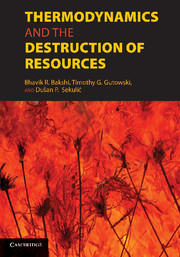Book contents
- Frontmatter
- Contents
- Contributor List
- Foreword by Herman E. Daly
- Foreword by Jan Szargut
- Preface
- Introduction
- PART I FOUNDATIONS
- PART II PRODUCTS AND PROCESSES
- PART III LIFE-CYCLE ASSESSMENTS AND METRICS
- PART IV ECONOMIC SYSTEMS, SOCIAL SYSTEMS, INDUSTRIAL SYSTEMS, AND ECOSYSTEMS
- 14 Early Development of Input–Output Analysis of Energy and Ecologic Systems
- 15 Exergoeconomics and Exergoenvironmental Analysis
- 16 Entropy, Economics, and Policy
- 17 Integration and Segregation in a Population – a Thermodynamicist's View
- 18 Exergy Use in Ecosystem Analysis: Background and Challenges
- 19 Thoughts on the Application of Thermodynamics to the Development of Sustainability Science
- Appendix: Standard Chemical Exergy
- Index
- References
19 - Thoughts on the Application of Thermodynamics to the Development of Sustainability Science
Published online by Cambridge University Press: 01 June 2011
- Frontmatter
- Contents
- Contributor List
- Foreword by Herman E. Daly
- Foreword by Jan Szargut
- Preface
- Introduction
- PART I FOUNDATIONS
- PART II PRODUCTS AND PROCESSES
- PART III LIFE-CYCLE ASSESSMENTS AND METRICS
- PART IV ECONOMIC SYSTEMS, SOCIAL SYSTEMS, INDUSTRIAL SYSTEMS, AND ECOSYSTEMS
- 14 Early Development of Input–Output Analysis of Energy and Ecologic Systems
- 15 Exergoeconomics and Exergoenvironmental Analysis
- 16 Entropy, Economics, and Policy
- 17 Integration and Segregation in a Population – a Thermodynamicist's View
- 18 Exergy Use in Ecosystem Analysis: Background and Challenges
- 19 Thoughts on the Application of Thermodynamics to the Development of Sustainability Science
- Appendix: Standard Chemical Exergy
- Index
- References
Summary
Introduction
The term sustainability is used frequently now in many different contexts. For example, in the area of engineering, there have been claims of sustainable products, sustainable manufacturing, sustainable designs, and so forth. Although these uses may be well intended, they actually marginalize the term by implying that just getting better in some way is sustainable. Instead, sustainability needs to be connected to a worldview that encompasses how human society can maintain a good quality of life over a long time. Without this worldview framework, these claims of sustainable this and sustainable that ring hollow. In this context, we are inspired by the work of the authors (mostly economists with biological scientists) of the paper, Arrow et al. [1]. By starting with the well-known statement of sustainability from the UN Brundtland Report [2], they developed a measurable and workable (though controversial) criterion for sustainability.
The Brundtland UN Commission statement on sustainability says, “sustainable development is the development that meets the needs of the present generation without compromising the ability of future generations to meet their own needs.” This statement brings up many value-laden issues and at first blush seems unworkable. For example, what is a need for one person could be considered excessive consumption for another. Furthermore, who is to speak for future generations and to articulate their needs? In addition, what development means is of crucial importance, in particular, does development require growth, and if so, what kind.
Information
- Type
- Chapter
- Information
- Thermodynamics and the Destruction of Resources , pp. 477 - 488Publisher: Cambridge University PressPrint publication year: 2011
References
Accessibility standard: Unknown
Why this information is here
This section outlines the accessibility features of this content - including support for screen readers, full keyboard navigation and high-contrast display options. This may not be relevant for you.Accessibility Information
- 2
- Cited by
